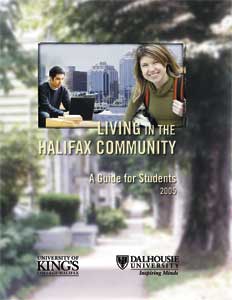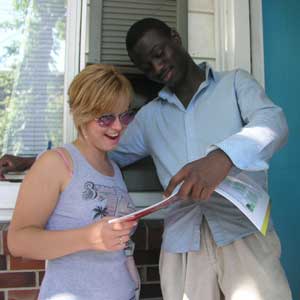 |
| Living in the Halifax Community - A guide for students |
Living in the downtown core can be challenging for new students and their neighbours so ะยผำฦยม๙บฯฒสฟชฝฑึฑฒฅ and the University of King's College have collaborated again on the booklet Living in the Halifax Community: A Guide for Students.
The 32-page booklet is quite a change from last year's plainer version, which had text but no photos or colour. This year, the booklet has been designed by Gail LeBlanc of Communications and Marketing. It is highlighted with colour and with photographs shot by staff photographer Danny Abriel and others.
Approximately 4,000 booklets were delivered door-to-door to student houses and apartments on Friday, Sept. 2 and Tuesday, Sept. 6 in a huge area of peninsular Halifax, stretching from Chebucto Road in the northwest to the Fenwick and Green Street areas in the south end.
The 2005 booklet repeats some of the features that students ranked high on their list of information needs: handy contact numbers, information about garbage recycling and composting, and easy recipes for lasagna, chili and other student favorites.
"Recipes ranked number two during focus groups and surveys conducted in the winter when we evaluated the first booklet," says Mary Somers, manager of Communications and Marketing at ะยผำฦยม๙บฯฒสฟชฝฑึฑฒฅ. "Number one on their need-for-information wish list was how to handle the garbage and the recyclables."
 |
| Lauren Grandy of Kinesiology and Tobin Ansong of Computer Science |
The booklet also tries to help students integrate into the community and to understand their responsibilities as neighbours in residential areas. "Students share the host neighbourhoods they live in for the three or four years while they study," says Somers. "So the booklet also provides tips on living, studying and working - how to be a good neighbour, how to acquire tenant's fire insurance and how to stay safe."
This year's book also contains a page listing the fines for tickets issued under the noise by-law and under the Liquor Control Act. "This may seem a bit of a scare tactic," says Somers, "but students asked us for this information. For example, the noise by-law minimum fine is now $300 for the first ticket and $1,000 for a third ticket. Drinking under age can net a $445 fine. That's a lot of money that could be spent on textbooks or living expenses. We want to help our students so they know the consequences of certain actions."
The 2005 booklet is different in another way. Somers and business commerce co-op student Evan Radisic raised much of the money for printing costs from advertisers. As well, the ะยผำฦยม๙บฯฒสฟชฝฑึฑฒฅ Student Union and the University of King's College where generous contributors.
